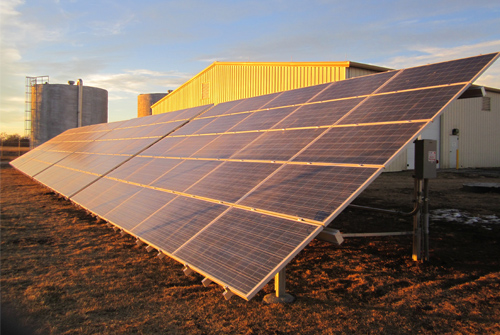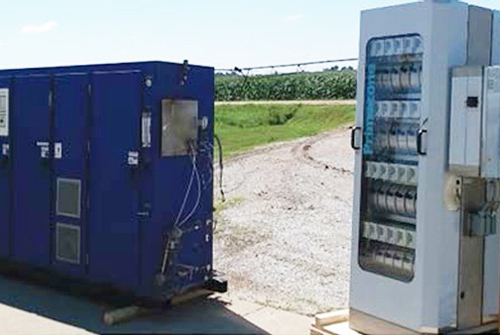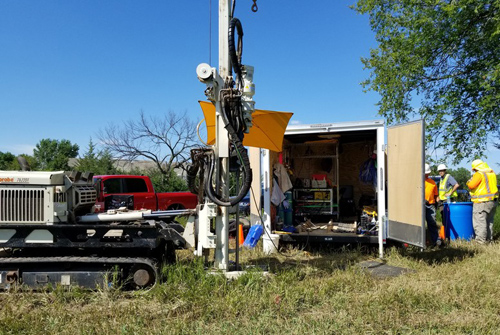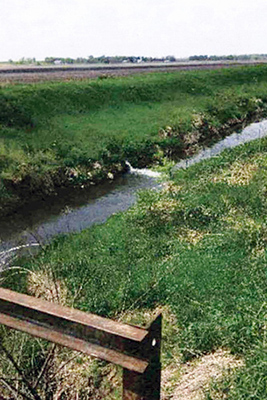Green Remediation Focus
Former Nebraska Ordance Plant
Mead, Nebraska
Federal Facility, Superfund NPL
Cleanup Objectives: Remediate soil and groundwater contaminated by trichloroethene (TCE) and other volatile organic compounds (VOCs) or explosives associated with past use of the site for munitions productions and storage, ammonium nitrate production, and agricultural research and development (R&D). Cleanup at this 17,000-acre rural site has involved incinerating explosives-contaminated soil, excavating and disposing of R&D waste offsite, and operating a groundwater pump and treat (P&T) system for each of four plumes. Soil remediation was completed in 2012.
Green Remediation Strategy: Reduce the environmental footprint of long-term groundwater cleanup activities by:
- Using onsite resources to generate renewable energy that directly operates or offsets grid electricity used for remedial purposes.
- Optimizing P&T operations such as granular activated carbon (GAC) adsorption, air stripping, and advanced oxidation processes (AOP) involving ultraviolet (UV) photolysis or ozone/hydrogen peroxide treatment.
- Using advanced site characterization techniques to refine the conceptual site model and further delineate potential contaminant source(s) as groundwater cleanup continues; modeling suggests that the cleanup goals will be reached in approximately 2130.
- Diverting treated groundwater for beneficial use.
Results:
Renewable Energy Generation
- Reduced the amount of grid electricity used to operate the site's single groundwater circulation system by 26% through use of an onsite, 10-kilowatt (kW) wind turbine in 2004 through 2011. Intermittent operation of the turbine to directly power the system's 230-volt submersible pump was estimated to decrease pumping-related carbon dioxide emissions by 24-32%. Due to severe damage to the turbine during a thunderstorm, the turbine and auxiliary equipment were decommissioned.
- Offset approximately 535,700 kW hours of grid electricity used for groundwater treatment as of January 2020 through use of three 25-kW photovoltaic (PV) arrays installed in 2014. The arrays were installed near two of the groundwater treatment plants and a focused extraction well and are inspected on a weekly basis. The solar energy production is anticipated to provide a $90,000 energy savings to the site over the initial 10 years of operation.
Groundwater P&T Optimization
- Reduced the amount of electricity needed to operate the site's UV photolysis system, which has involved incremental installation of a UV unit near each of seven wellheads since 2008. The UV unit installed most recently, in 2017, has a higher capacity and consumes approximately 60 percent less energy than the earlier installed units. Selection of this unit allowed for one older UV unit to be taken offline and for the newer high-efficiency UV unit to treat groundwater extracted from two wells instead of a single well.
- Eliminated use of approximately 120,000 pounds of GAC each year to operate a liquid-phase GAC system for treating hexahydro-1,3,5-trinitro-1,3,5-triazine (RDX) at one of the groundwater treatment plants, by switching to the wellhead treatment UV systems. The GAC system had operated for nine years.
- Increased efficiency of the site's ozone treatment system operating at a single treatment plant by replacing the aged (12-year-old) ozone generator with a new higher-capacity generator capable of generating 5% more ozone than the previous generator. The new generator may allow for reduction or elimination of hydrogen peroxide use at the plant, at a savings of $15,000-$30,000 per year.
- Maintaining operating efficiency of the groundwater extraction wells as needed by rehabilitating ones that exhibit or approach a decrease of more than 20 percent in specific capacity, when compared to their originally calculated peak capacities. In 2017, for example, four of the wells were rehabilitated through brushing, high-velocity jetting, airlifting, acidification, disinfection, and surging procedures. A total of approximately 1.21 billion gallons of water was extracted for onsite treatment during that year.
- Eliminated the need for vapor-phase GAC units supporting air stripping at two of the groundwater treatment plants. At the time of shutdown, air sampling and associated modeling indicated that TCE emissions would remain below the emissions threshold of 5 tons per year.
Advanced Site Characterization
- Minimized the number of air samples initially needing to be collected and analyzed at an offsite laboratory by deploying the U.S. Environmental Protection Agency's trace atmospheric gas analyzer (TAGA) mobile laboratory. The screening data were used to refine original delineation of the site's VOC-contaminated groundwater plumes.
- Optimized locations of 69 new monitoring wells in 2019 through use of a heliborne electromagnetic (EM) survey. The EM measurements were collected in 2015 and combined with conventional sampling data to delineate potential contamination in the site's underlaying Omadi Formation, a bedrock layer consisting of sandstone with thin layers of shale below sands and gravels. Approximately 400 monitoring wells were installed previously.
- Using direct-push rigging equipped with a membrane interface probe and hydraulic profile tooling (MiHPT) to generate profiles containing down-hole information such as hydrocarbon and solvent contamination, soil electrical conductance, and permeability. Wherever MiHPT readings show the presence of contamination, groundwater samples are collected and analyzed to determine TCE or RDX concentrations that may indicate potential source areas.
Water Conservation
- Enabling beneficial reuse of a portion of the effluent from two of the site's four treatment plants that otherwise discharges into surface water (Clear Creek). As originally designed, the Clear Creek outfall supplies irrigation water to the site's existing agricultural R&D facility and two of the site's privately-owned properties and provides a source of water for potential fire suppression.
- Increased the annual capacity for beneficial use of the site's treated water to approximately 25-33 percent, by modifying the effluent handling system at a groundwater treatment plant that was originally designed to fully discharge to other surface waters (Wahoo Creek). Installation of a bypass valve and auxiliary piping at the plant now diverts treated water toward Clear Creek, as needed, and additional private property owners have access to the water for non-potable use.
Property End Use: Continued agricultural R&D, residential, and commercial use
Point of Contact: Bill Gresham, U.S. Environmental Protection Agency, Region 7
Update: February 2020













